The AMD Threadripper 2 CPU Review: The 24-Core 2970WX and 12-Core 2920X Tested
by Ian Cutress on October 29, 2018 9:00 AM ESTGaming: Ashes Classic (DX12)
Seen as the holy child of DirectX12, Ashes of the Singularity (AoTS, or just Ashes) has been the first title to actively go explore as many of the DirectX12 features as it possibly can. Stardock, the developer behind the Nitrous engine which powers the game, has ensured that the real-time strategy title takes advantage of multiple cores and multiple graphics cards, in as many configurations as possible.
As a real-time strategy title, Ashes is all about responsiveness during both wide open shots but also concentrated battles. With DirectX12 at the helm, the ability to implement more draw calls per second allows the engine to work with substantial unit depth and effects that other RTS titles had to rely on combined draw calls to achieve, making some combined unit structures ultimately very rigid.
Stardock clearly understand the importance of an in-game benchmark, ensuring that such a tool was available and capable from day one, especially with all the additional DX12 features used and being able to characterize how they affected the title for the developer was important. The in-game benchmark performs a four minute fixed seed battle environment with a variety of shots, and outputs a vast amount of data to analyze.
For our benchmark, we run Ashes Classic: an older version of the game before the Escalation update. The reason for this is that this is easier to automate, without a splash screen, but still has a strong visual fidelity to test.
| AnandTech CPU Gaming 2019 Game List | ||||||||
| Game | Genre | Release Date | API | IGP | Low | Med | High | |
| Ashes: Classic | RTS | Mar 2016 |
DX12 | 720p Standard |
1080p Standard |
1440p Standard |
4K Standard |
|
Ashes has dropdown options for MSAA, Light Quality, Object Quality, Shading Samples, Shadow Quality, Textures, and separate options for the terrain. There are several presents, from Very Low to Extreme: we run our benchmarks at the above settings, and take the frame-time output for our average and percentile numbers.
All of our benchmark results can also be found in our benchmark engine, Bench.
| Game | IGP | Low | Medium | High |
| Average FPS | 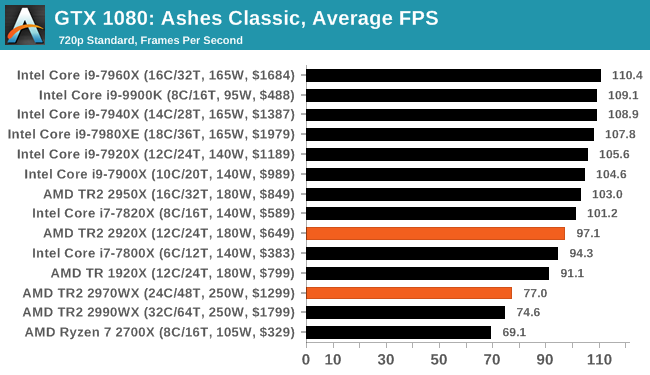 |
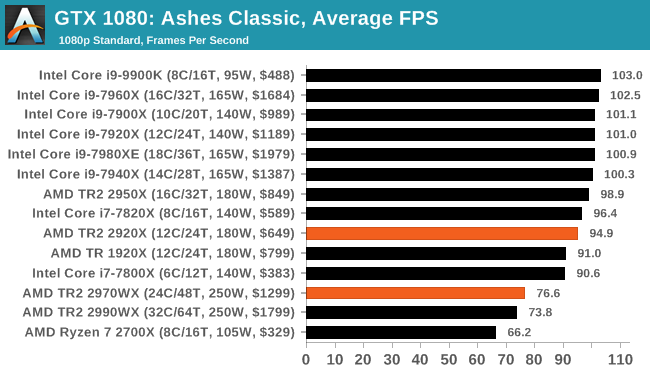 |
 |
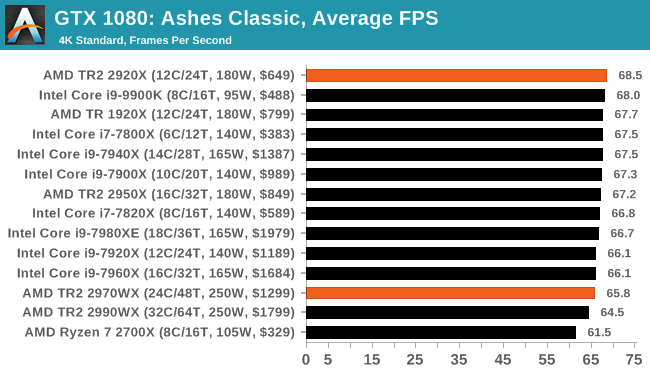 |
| 95th Percentile | 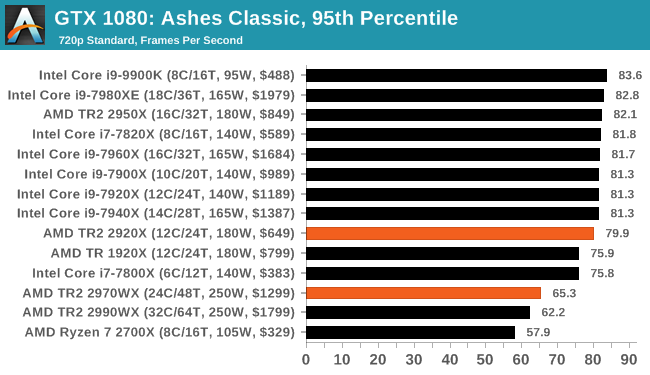 |
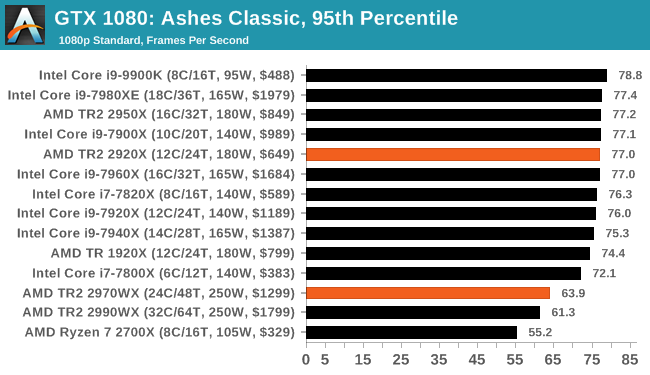 |
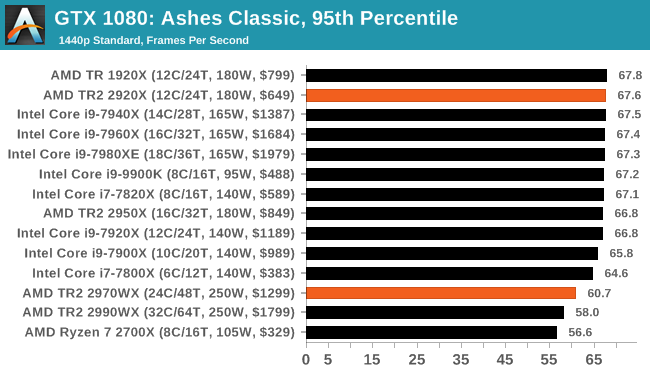 |
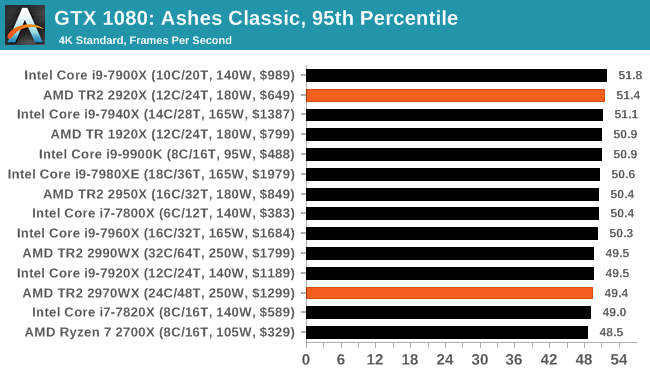 |












69 Comments
View All Comments
snowranger13 - Monday, October 29, 2018 - link
On the AMD SKUs slide you show Ryzen 7 2700X has 16 PCI-E lanes. It actually has 20 (16 to PCI-E slots + 4 to 1x M.2)Ian Cutress - Monday, October 29, 2018 - link
Only 16 for graphics use. We've had this discussion many times before. Technically the silicon has 32.Nioktefe - Monday, October 29, 2018 - link
Many motherboards can use that 4 additionnal lanes as classic pci-ehttps://www.asrock.com/mb/AMD/B450%20Pro4/index.as...
mapesdhs - Monday, October 29, 2018 - link
Sure, but not for SLI. It's best for clarity's sake to exclude chipset PCIe in the lane count, otherwise we'll have no end of PR spin madness.Ratman6161 - Monday, October 29, 2018 - link
Ummm...there are lots of uses for more PCIe besides SLI ! Remember that while people do play games on these platforms, it would not make any sense to buy one of these for the purpose of playing games. You buy it for work and if it happens to game OK then great.TheinsanegamerN - Tuesday, October 30, 2018 - link
Is it guaranteed to be wired up to a physical slot?No?
then it is optional, and advertising it as being guaranteed available for expansion would be false advertising.
TechnicallyLogic - Thursday, February 28, 2019 - link
By that logic, Intel CPUs have no PCIE slots, as there are LGA 1151 Mini STX motherboards with no x16 slot at all. I think a good compromise would be to list the CPU as having 16+4 PCIE slots.Yorgos - Friday, November 2, 2018 - link
for clarity's sake they should report the 9900k at 250Watt TDP.selective clarity is purch media's approach, though.
2700x has 20 pcie lanes, period. if some motherboard manufacturers use it for nvme or as an extra x4 pcie slot, it's not up to debate for a "journalist" to include it or exclude it, it's fucking there.
unless the money are good ofc... everyone has their price.
TheGiantRat - Monday, October 29, 2018 - link
Technically the silicon of each die has total of 128 PCI-E lanes. Each die on Ryzen Threadripper and Epyc has 64 lanes for external buses and 64 lanes for IF. Therefore, the total is 128 lanes. They just have it limited to 20 lanes for consumer grade CPUs.atragorn - Monday, October 29, 2018 - link
Why are the epyc scores so low across the board? I dont expect it to game well but it was at the bottom or close to it for everything it seemed